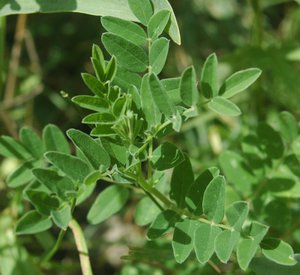
Pinyin: Huang Qi Latin: Astragalus Membranaceus
Physical Characteristics
Astragalus Membranaceus is a perennial growing to 0.3m by 0.3m, is hardy to zone 6 and is in flower from June to August. Astragalus Membranaceus seeds ripen from July to September. The flowers are hermaphrodite (have both male and female organs) and are pollinated by Bees, Lepidoptera (Moths & Butterflies). Huang Qi can fix Nitrogen. The plant prefers light (sandy) and medium (loamy) soils and requires well-drained soil. The plant prefers neutral and basic (alkaline) soils, cannot grow in the shade and requires dry soil.
Family
Traditional Chinese Medicinal (TCM) Uses:*
Huang Qi is commonly used in Chinese herbalism, where it is considered to be one of the 50 fundamental herbs[218]. The root is a sweet tonic herb that stimulates the immune system and many organs of the body, whilst lowering blood pressure and blood sugar levels[238].*
Astragalus Membranaceus is particularly suited to young, physically active people, increasing stamina and endurance and improving resistance to the cold - indeed for younger people it is perhaps superior to ginseng in this respect[254].*
Huang Qi is used especially for treatment of the kidneys and also to avoid senility[218]. The plant is often used in conjunction with other herbs such as Atractylodes macrocephala and Ledebouriella seseloides[238].*
Astragalus root contains a number of bio-active constituents including saponins and isoflavonoids[279]. Astragalus is adaptogen, antipyretic, diuretic, tonic, uterine stimulant and vasodilator[218, 254, 279].*
Astragalus is used in the treatment of cancer, prolapse of the uterus or anus, abscesses and chronic ulcers, chronic nephritis with oedema and Proteinuria[176, 218]. Recent research in the West has shown that the root can increase the production of interferon and macrophages and thus help restore normal immune function in cancer patients[254, 279].*
Patients undergoing chemotherapy or radiotherapy recover faster and live longer if given Huang Qi concurrently[254]. The root of 4 year old plants is harvested in the autumn and dried for later use[238, 254]. The plant is antipyretic, diuretic, pectoral and tonic[218]. Extracts of the plant are bactericidal, hypoglycaemic and hypotensive[218]. Cardiotonic, vasodilator[176].*
References
- [176] Yeung. Him-Che.Handbook of Chinese Herbs and Formulas. Institute of Chinese Medicine, Los Angeles 1985
- [218] Duke. J. A. and Ayensu. E. S.Medicinal Plants of China Reference Publications, Inc. 1985 ISBN 0-917256-20-4
- [238] Bown. D.Encyclopaedia of Herbs and their Uses. Dorling Kindersley, London. 1995 ISBN 0-7513-020-31
- [254] Chevallier. A.The Encyclopedia of Medicinal Plants Dorling Kindersley. London 1996 ISBN 9-780751-303148
- [261] Yakovlev. G. Sytin. A. & Roskov. Yu.Legumes of Northern Eurasia Royal Botanic gardens, Kew. 1996 ISBN 0-947643-97-4
- [279] Medicinal Plants in the Republic of Korea World Health Organisation, Manila 1998 ISBN 92 9061 120 0
Source: Astragalus Membranaceus Plants For A Future, England 1996-2008.
This work is licensed under a Creative Commons License.
Natural dietary supplements are designed to offer the body support to promote health, harmony, balance and overall well being.*
\

 Get Well Natural, LLC
Get Well Natural, LLC  Kidney Function & Regeneration Health
Kidney Function & Regeneration Health  Platelet & Blood Cell Health
Platelet & Blood Cell Health  Prostate, Flow & Function Health
Prostate, Flow & Function Health  General Mind & Body Health
General Mind & Body Health  Heart, Cholesterol & Cardio Health
Heart, Cholesterol & Cardio Health  Allergy-Free Body
Allergy-Free Body  Anxiety & Stress
Anxiety & Stress  Blood Platelet Counts & Function
Blood Platelet Counts & Function  Blood Pressure Health
Blood Pressure Health  Kidney Health
Kidney Health  Immune System Health & Balance
Immune System Health & Balance  Prostate & Urinary Health Function
Prostate & Urinary Health Function  Blood Sugar Balance
Blood Sugar Balance  Cardiovascular Heart Health
Cardiovascular Heart Health  Detoxification & Healthy Cells
Detoxification & Healthy Cells  Women's Health
Women's Health  Liver Regeneration
Liver Regeneration  Pain-Free Body
Pain-Free Body  Water & Air Filtration
Water & Air Filtration 


